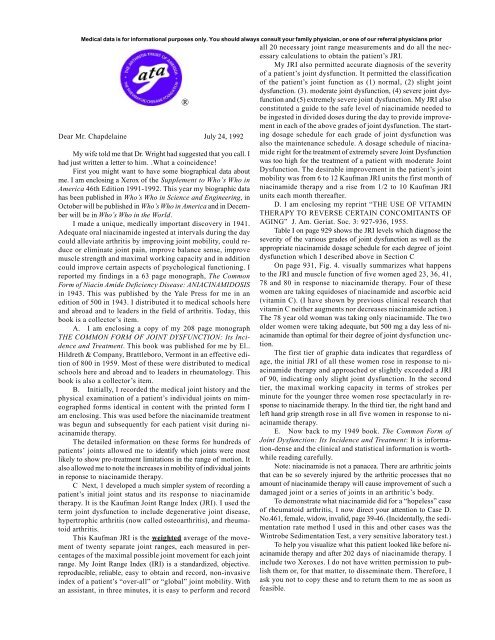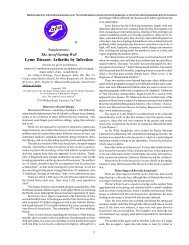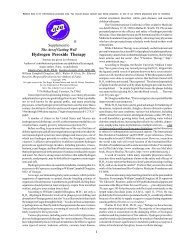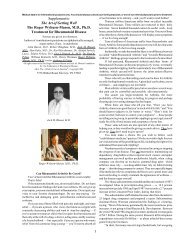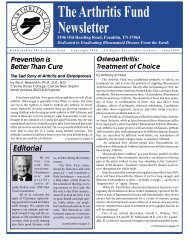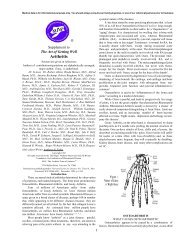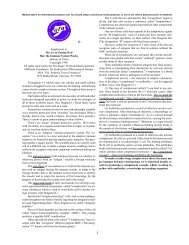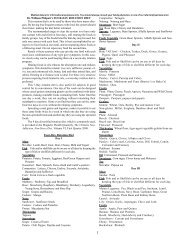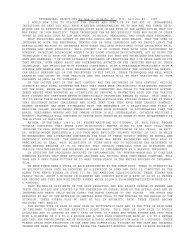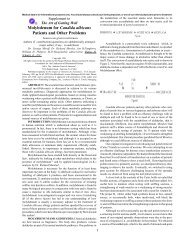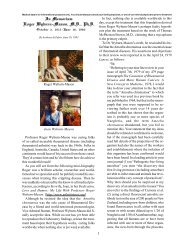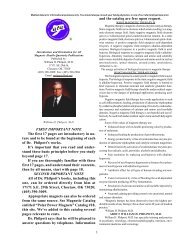William Kaufman 1992-07-24 – PDF - Arthritis Trust of America
William Kaufman 1992-07-24 – PDF - Arthritis Trust of America
William Kaufman 1992-07-24 – PDF - Arthritis Trust of America
Create successful ePaper yourself
Turn your PDF publications into a flip-book with our unique Google optimized e-Paper software.
Medical data is for informational purposes only. You should always consult your family physician, or one <strong>of</strong> our referral physicians priorall 20 necessary joint range measurements and do all the necessarycalculations to obtain the patient’s JRI.My JRI also permitted accurate diagnosis <strong>of</strong> the severity<strong>of</strong> a patient’s joint dysfunction. It permitted the classification<strong>of</strong> the patient’s joint function as (1) normal, (2) slight jointdysfunction. (3). moderate joint dysfunction, (4) severe joint dysfunctionand (5) extremely severe joint dysfunction. My JRI also®constituted a guide to the safe level <strong>of</strong> niacinamide needed tobe ingested in divided doses during the day to provide improvementin each <strong>of</strong> the above grades <strong>of</strong> joint dysfunction. The startingdosage schedule for each grade <strong>of</strong> joint dysfunction wasDear Mr. Chapdelaine July <strong>24</strong>, <strong>1992</strong>also the maintenance schedule. A dosage schedule <strong>of</strong> niacinamideright for the treatment <strong>of</strong> extremely severe Joint DysfunctionMy wife told me that Dr. Wright had suggested that you call. Ihad just written a letter to him. .What a coincidence!was too high for the treatment <strong>of</strong> a patient with moderate JointFirst you might want to have some biographical data about Dysfunction. The desirable improvement in the patient’s jointme. I am enclosing a Xerox <strong>of</strong> the Supplement to Who’s Who in mobility was from 6 to 12 <strong>Kaufman</strong> JRI units the first month <strong>of</strong><strong>America</strong> 46th Edition 1991-<strong>1992</strong>. This year my biographic data niacinamide therapy and a rise from 1/2 to 10 <strong>Kaufman</strong> JRIhas been published in Who’s Who in Science and Engineering, in units each month thereafter.October will be published in Who’s Who in <strong>America</strong> and in Decemberwill be in Who’s Who in the World.THERAPY TO REVERSE CERTAIN CONCOMITANTS OFD. I am enclosing my reprint “THE USE OF VITAMINI made a unique, medically important discovery in 1941. AGING” J. Am. Geriat. Soc. 3: 927-936, 1955.Adequate oral niacinamide ingested at intervals during the day Table I on page 929 shows the JRI levels which diagnose thecould alleviate arthritis by improving joint mobility, could reduceor eliminate joint pain, improve balance sense, improve appropriate niacinamide dosage schedule for each degree <strong>of</strong> jointseverity <strong>of</strong> the various grades <strong>of</strong> joint dysfunction as well as themuscle strength and maximal working capacity and in addition dysfunction which I described above in Section Ccould improve certain aspects <strong>of</strong> psychological functioning. I On page 931, Fig. 4. visually summarizes what happensreported my findings in a 63 page monograph, The Common to the JRI and muscle function <strong>of</strong> five women aged 23, 36, 41,Form <strong>of</strong> Niacin Amide Deficiency Disease: ANIACINAMIDOSIS 78 and 80 in response to niacinamide therapy. Four <strong>of</strong> thesein 1943. This was published by the Yale Press for me in an women are taking equidoses <strong>of</strong> niacinamide and ascorbic acidedition <strong>of</strong> 500 in 1943. I distributed it to medical schools here (vitamin C). (I have shown by previous clinical research thatand abroad and to leaders in the field <strong>of</strong> arthritis. Today, this vitamin C neither augments nor decreases niacinamide action.)book is a collector’s item.The 78 year old woman was taking only niacinamide. The twoA. I am enclosing a copy <strong>of</strong> my 208 page monograph older women were taking adequate, but 500 mg a day less <strong>of</strong> niacinamidethan optimal for their degree <strong>of</strong> joint dysfunction unc-THE COMMON FORM OF JOINT DYSFUNCTION: Its Incidenceand Treatment. This book was published for me by El.. tion.Hildreth & Company, Brattleboro, Vermont in an effective edition<strong>of</strong> 800 in 1959. Most <strong>of</strong> these were distributed to medical age, the initial JRI <strong>of</strong> all these women rose in response to ni-The first tier <strong>of</strong> graphic data indicates that regardless <strong>of</strong>schools here and abroad and to leaders in rheumatology. This acinamide therapy and approached or slightly exceeded a JRIbook is also a collector’s item.<strong>of</strong> 90, indicating only slight joint dysfunction. In the secondB. Initially, I recorded the medical joint history and the tier, the maximal working capacity in terms <strong>of</strong> strokes perphysical examination <strong>of</strong> a patient’s individual joints on mimeographedforms identical in content with the printed form I sponse to niacinamide therapy. In the third tier, the right hand andminute for the younger three women rose spectacularly in re-am enclosing. This was used before the niacinamide treatment left hand grip strength rose in all five women in response to niacinamidetherapy.was begun and subsequently for each patient visit during niacinamidetherapy.E. Now back to my 1949 book. The Common Form <strong>of</strong>The detailed information on these forms for hundreds <strong>of</strong> Joint Dysfunction: Its Incidence and Treatment: It is information-denseand the clinical and statistical information is worth-patients’ joints allowed me to identify which joints were mostlikely to show pre-treatment limitations in the range <strong>of</strong> motion. It while reading carefully.also allowed me to note the increases in mobility <strong>of</strong> individual joints Note: niacinamide is not a panacea. There are arthritic jointsin reponse to niacinamide therapy.that can be so severely injured by the arthritic processes that noC Next, 1 developed a much simpler system <strong>of</strong> recording a amount <strong>of</strong> niacinamide therapy will cause improvement <strong>of</strong> such apatient’s initial joint status and its response to niacinamide damaged joint or a series <strong>of</strong> joints in an arthritic’s body.therapy. It is the <strong>Kaufman</strong> Joint Range Index (JRI). I used the To demonstrate what niacinamide did for a “hopeless” caseterm joint dysfunction to include degenerative joint disease, <strong>of</strong> rheumatoid arthritis, I now direct your attention to Case D.hypertrophic arthritis (now called osteoarthritis), and rheumatoidarthritis.mentation rate method I used in this and other cases was theNo.461, female, widow, invalid, page 39-46. (Incidentally, the sedi-This <strong>Kaufman</strong> JRI is the weighted average <strong>of</strong> the movement<strong>of</strong> twenty separate joint ranges, each measured in per-To help you visualize what this patient looked like before ni-Wintrobe Sedimentation Test, a very sensitive laboratory test.)centages <strong>of</strong> the maximal possible joint movement for each joint acinamide therapy and after 202 days <strong>of</strong> niacinamide therapy. Irange. My Joint Range Index (IRI) is a standardized, objective. include two Xeroxes. I do not have written permission to publishthem or, for that matter, to disseminate them. Therefore, Ireproducible, reliable, easy to obtain and record, non-invasiveindex <strong>of</strong> a patient’s “over-all” or “global” joint mobility. With ask you not to copy these and to return them to me as soon asan assistant, in three minutes, it is easy to perform and record feasible.
Medical data is for informational purposes only. You should always consult your family physician, or one <strong>of</strong> our referral physicians priorNow please read this patient’s entire history, physical examinationand her clinical course in response to 202 days <strong>of</strong> indi-K. You no doubt have a copy <strong>of</strong> Dr. Wright’s Preventionpatient will tolerate this lower daily dose without nausea.vidualized niacinamide therapy.Clinic: A CASE OF ARTHRITIS <strong>of</strong> March 1977 in which heThe clinical evidence is that this patient did have enough describes Mrs. Arthur’s excellent response to niacinamidehelp from 212 days <strong>of</strong> niacinamide therapy to improve her generalhealth, to make some <strong>of</strong> her seriously affected rheumatoid joints L. There is one more thing I wish to call to your atten-therapy.more mobile and pain free, provide her with more physical stamina tion:. Niacinamide tablets are an inexpensive medication forand muscle strength and also make her life pleasanter and more the treatment <strong>of</strong> joint dysfunction.comfortable than she had believed would ever be possible. Imerely cite this case to show the therapeutic power <strong>of</strong> niacinamideeven in as severe a case <strong>of</strong> rheumatoid arthritis as this. SincerelyWith kindest regards,F. Next I want to call your attention to the graph on page <strong>William</strong> <strong>Kaufman</strong>, Ph.D., M.D.153. The JRI’s <strong>of</strong> 455 persons in the untreated population werearranged in successive 5-year groups, thus making a linear graphwhich represented the central tendency <strong>of</strong> decline <strong>of</strong> thesucccessive Joint Range Indexes with age. The algebraic formulafor this line is not in this book. However, for this decliningline it is as follows: JRI = --0.42 x AGE +92.2.G. I am enclosing a larger version <strong>of</strong> “THE LINEARDECLINE IN THE JOINT RANGE INDEX WITH INCREAS-ING AGE” for you. In addition, I am enclosing another graphshowing how I used the above graph in patient care .The graph <strong>of</strong> Case # 330 Female Age 78 shows (A) herJRI before beginning niacinamide therapy and (B) her JRI after417 days <strong>of</strong> niacinamide therapy which has ascended thelinear graph from point A to point B. Her initial pretreatmentJRI was 70. thus slightly better than expected for her age. (Naturalvariation from the mean accounts for this difference.) HerJRl on her 417th day <strong>of</strong> treatment with niacinamide correspondedto what one would expect <strong>of</strong> a 28 year old woman.This large increase in her JRI indicated she had gained greatlyincreased joint flexibility with niacinamide therapy, a thing she alreadyknew from experience.. Showing a patient the progressthey have made with niacinamide therapy in this manner is veryencouraging to the patient. (Conversely if the patient reducesor stops niacinamide therapy, the loss <strong>of</strong> improvement is sostriking when plotted on this graph in terms <strong>of</strong> years <strong>of</strong> JRIflexibility lost that the patient usually becomes very faithful intaking the prescribed amounts <strong>of</strong> niacinamide.)U. I am also enclosing a reprint <strong>of</strong> my Tom Spies MemorialLecture, “Niacinamide: A most Neglected Vitamin,” whichwas published in the Journal <strong>of</strong> the International Academy <strong>of</strong>Preventive Medicine in 1983. On pages 22 and 23 you can seewhat happened to the JRI ’ s <strong>of</strong> four patients having 12, 16, 17and 19 years <strong>of</strong> niacinamide therapy and how these rise to alevel much higher than the anticipated decline in the JRI with agein patients not treated with niacinamide.I .In addition, I am sending you a marked Xerox <strong>of</strong> A.H<strong>of</strong>fer. Ph.D.. M.D. Treatment <strong>of</strong> <strong>Arthritis</strong> by Nicotinic Acidand Nicotinamide, Canadian Medical Association Journal 81,235-238. Aug. 15. 1959. This provides an accurate summary<strong>of</strong> the history <strong>of</strong> my niacinamide work up to that date as well asDr. H<strong>of</strong>fer’s six cases.J. In my series <strong>of</strong> patients, there have been no adverseside effects from the manner in which I prescribed niacinamidefor the treatment <strong>of</strong> joint dysfunction. I treated over 1500patients with niacinamide for joint dysfunction, and none <strong>of</strong> theseever experienced nausea. However, a doctor can prescribe dailydoses <strong>of</strong> niacinamide that are so large that this causes the patientto have nausea. When this occurs, it indicates that thedaily dose <strong>of</strong> niaicnamide prescribed was one gram a day higherthan the patient’s tolerance. If nausea occurs, the total daily intake<strong>of</strong> niacinamide needs to be reduced by a gram a day; then the
Medical data is for informational purposes only. You should always consult your family physician, or one <strong>of</strong> our referral physicians prior
Medical data is for informational purposes only. You should always consult your family physician, or one <strong>of</strong> our referral physicians prior
Medical data is for informational purposes only. You should always consult your family physician, or one <strong>of</strong> our referral physicians prior
Medical data is for informational purposes only. You should always consult your family physician, or one <strong>of</strong> our referral physicians prior
Medical data is for informational purposes only. You should always consult your family physician, or one <strong>of</strong> our referral physicians prior
Medical data is for informational purposes only. You should always consult your family physician, or one <strong>of</strong> our referral physicians prior


